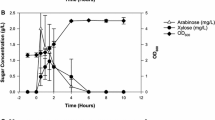Abstract
Many hyperthermophilic microorganisms show heterotrophic growth on a variety of carbohydrates. There has been considerable fundamental and applied interest in the utilization of glucose and its α- and β-polymers by hyperthermophiles. While glycolysis by Bacteria at high temperatures shows conventional characteristics, it has been found that glucose catabolism by hyperthermophilic Archaea differs from the canonical glycolytic pathways, involves novel enzymes, and shows a unique control. This review addresses these aspects with specific attention to Pyrococcus furiosus, which is one of the best studied hyperthermophilic Archaea, has the capacity to grow on a variety of sugars including the marine β-(1,3)-linked glucose polymer laminarin, and has been found to contain three novel glycolytic enzymes, two ADP-dependent kinases, and a ferredoxin-dependent glyceraldehyde-3-phosphate oxidoreductase.
Similar content being viewed by others
Author information
Authors and Affiliations
Additional information
Received: January 22, 1998 / Accepted: February 16, 1998
Rights and permissions
About this article
Cite this article
de Vos, W., Kengen, S., Voorhorst, W. et al. Sugar utilization and its control in hyperthermophiles. Extremophiles 2, 201–205 (1998). https://doi.org/10.1007/s007920050061
Issue Date:
DOI: https://doi.org/10.1007/s007920050061




